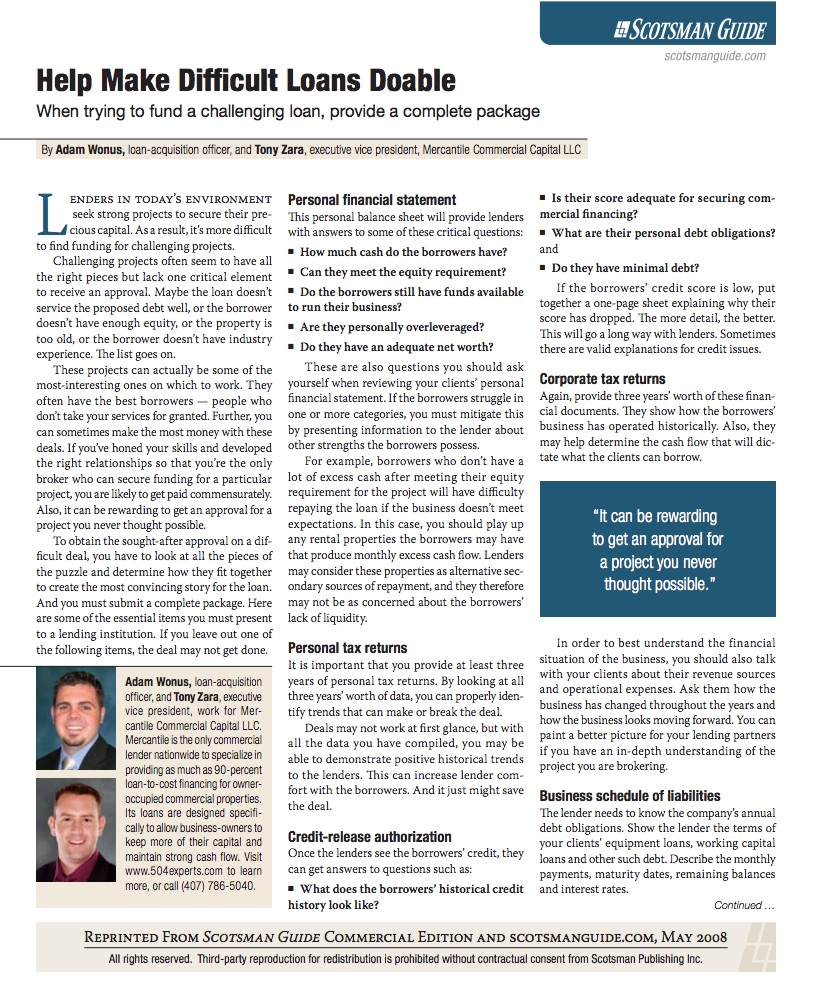
Lenders in today’s environment seek strong projects to secure their precious capital. As a result, it’s more difficult to find funding for challenging projects.
Challenging projects often seem to have all the right pieces but lack one critical element to receive an approval. Maybe the loan doesn’t service the proposed debt well, or the borrower doesn’t have enough equity, or the property is too old, or the borrower doesn’t have industry experience. The list goes on.
These projects can actually be some of the most-interesting ones on which to work. They often have the best borrowers -- people who don’t take your services for granted. Further, you can sometimes make the most money with these deals. If you’ve honed your skills and developed the right relationships so that you’re the only broker who can secure funding for a particular project, you are likely to get paid commensurately. Also, it can be rewarding to get an approval for a project you never thought possible.
To obtain the sought-after approval on a difficult deal, you have to look at all the pieces of the puzzle and determine how they fit together to create the most convincing story for the loan. And you must submit a complete package. Here are some of the essential items you must present to a lending institution. If you leave out one of the following items, the deal may not get done.
Personal financial statement
This personal balance sheet will provide lenders with answers to some of these critical questions:
- How much cash do the borrowers have?
- Can they meet the equity requirement?
- Do the borrowers still have funds available to run their business?
- Are they personally overleveraged?
- Do they have an adequate net worth?
These are also questions you should ask yourself when reviewing your clients’ personal financial statement. If the borrowers struggle in one or more categories, you must mitigate this by presenting information to the lender about other strengths the borrowers possess.
For example, borrowers who don’t have a lot of excess cash after meeting their equity requirement for the project will have difficulty repaying the loan if the business doesn’t meet expectations. In this case, you should play up any rental properties the borrowers may have that produce monthly excess cash flow. Lenders may consider these properties as alternative secondary sources of repayment, and they therefore may not be as concerned about the borrowers’ lack of liquidity.
Personal tax returns
It is important that you provide at least three years of personal tax returns. By looking at all three years’ worth of data, you can properly identify trends that can make or break the deal.
Deals may not work at first glance, but with all the data you have compiled, you may be able to demonstrate positive historical trends to the lenders. This can increase lender comfort with the borrowers. And it just might save the deal.
Credit-release authorization
Once the lenders see the borrowers’ credit, they can get answers to questions such as:
- What does the borrowers’ historical credit history look like?
- Is their score adequate for securing commercial financing?
- What are their personal debt obligations? and
- Do they have minimal debt?
If the borrowers’ credit score is low, put together a one-page sheet explaining why their score has dropped. The more detail, the better. This will go a long way with lenders. Sometimes there are valid explanations for credit issues.
Corporate tax returns
Again, provide three years’ worth of these financial documents. They show how the borrowers’ business has operated historically. Also, they may help determine the cash flow that will dictate what the clients can borrow.
In order to best understand the financial situation of the business, you should also talk with your clients about their revenue sources and operational expenses. Ask them how the business has changed throughout the years and how the business looks moving forward. You can paint a better picture for your lending partners if you have an in-depth understanding of the project you are brokering.
Business schedule of liabilities
The lender needs to know the company’s annual debt obligations. Show the lender the terms of your clients’ equipment loans, working capital loans and other such debt. Describe the monthly payments, maturity dates, remaining balances and interest rates.
Interim financial statements
Provide profit-and-loss statements and balance sheets from within the past 60 days for the company. They provide a snapshot of the company’s finances at any given point in the current fiscal year.
Too often, brokers provide lenders with three years of statements and ask for an approval. Lenders cannot give you an approval based on that alone. The interim statements are important to provide insight on the current year.
Project-cost breakdown
Provide explanations and estimates for all of the potential project costs. These include the following:
- Land
- Building/construction
- Equipment
- Site work
- Impact fees
Don’t leave out anything. If you list all possible costs, lenders can give you an accurate assessment of what costs they consider eligible and ineligible for their particular loan programs.
Intangibles
These can make or break a weak deal. They tell lenders why they should sign off on a project that may not quite service the debt at that current point in time. Your creative side must come into play with the intangibles.
Because you’ve spent time learning about your clients’ business, you should understand why the numbers look the way they do. As such, you can collectively present the mitigating factors. Provide pictures of the property. Point out areas of the loan package that might be missed in a cursory review such as secondary sources of repayment, a business expansion or excess cash flow from other investments.
How will these items impact the business moving forward? How will they ensure the successful repayment of this commercial loan? Explain the answers to these questions to improve your chances of closing the deal.

